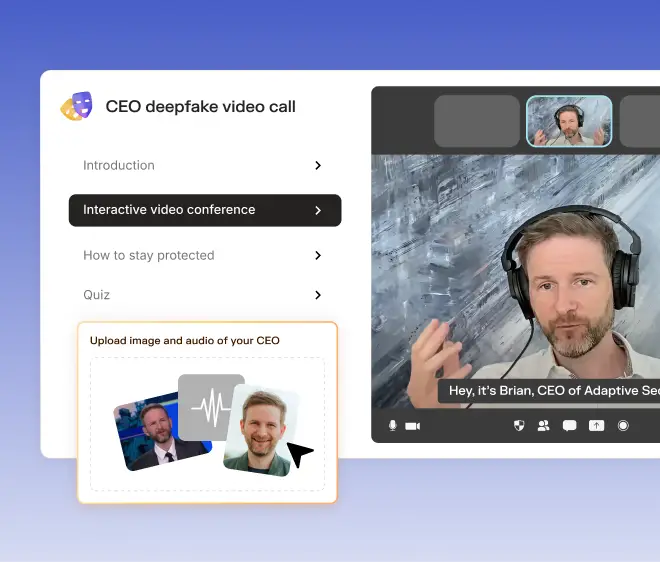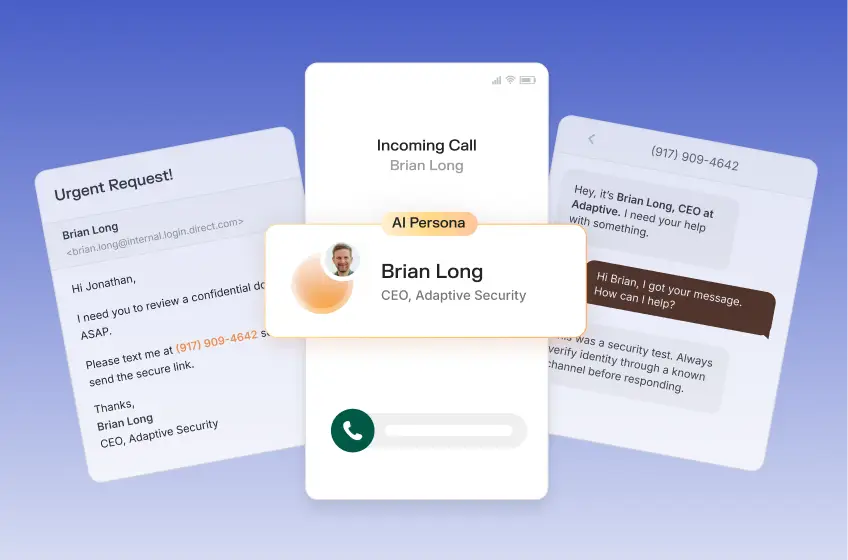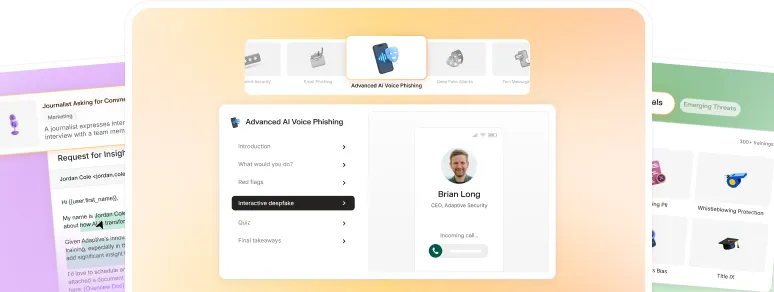AI phishing is surging, but phishing training for employees could reduce their exposure to data breaches by up to 90%.
How does that work? According to the U.S. Cybersecurity and Infrastructure Security Agency (CISA), more than 90% of successful cyberattacks start with a phishing email. Cybercriminals’ success is largely based on human error.
The good news is that CISOs and their teams can empower employees to identify and mitigate every type of phishing attack before it becomes a multimillion-dollar breach.
Cybercriminals are using AI to create phishing lures, including hyper-realistic deepfakes, that are nearly impossible to detect. However, next-generation security awareness training and AI-led phishing simulations enable organizations to fight back.
Adaptive Security, for example, offers multi-channel phishing training that leverages AI, behavioral analytics, and real-time data to mitigate data breach risk, all without overwhelming the IT and security teams responsible for training.
Why Phishing Risk Demands Enterprise-Level Training
Phishing isn’t an inbox issue. It’s an organization-wide priority, from the boardroom to the front lines. With more than 3.4 billion phishing emails sent daily, every employee must defend against industrialized social engineering.
Attackers rely on AI-powered phishing to bypass traditional defenses like endpoint security and firewalls. It’s now up to employees to do the heavy lifting, and all it takes is one click to deliver catastrophic harm to the entire business.
Otherwise, the organization is susceptible to:
- Financial losses from wire fraud, ransomware, scams, and extortion.
- Reputational fallout that erodes trust among customers, partners, investors, and the general public.
- Compliance violations tied to PCI DSS, HIPAA, and other regulatory frameworks.
- Operational downtime that disrupts services and revenue streams.
As attacks achieve a stunning level of personalization, your security awareness training must evolve accordingly.
The Surge of AI Phishing & Deepfakes
AI phishing is up 4,151% since the launch of OpenAI’s ChatGPT.
Phishing attacks range from deepfakes of colleagues on video conferences to AI voice spoofing calls, all designed to mimic trusted figures and trick employees into surrendering sensitive information or transferring funds.
Cybercriminals can quickly and, more concerningly, effectively target individuals using just a small amount of open-source intelligence (OSINT) for spear phishing.
Hidden Costs of a Single Click for Tech, Finance, and Healthcare Firms
The average cost of a data breach is approaching $5 million. However, the financial damage is only part of the equation after a data breach hits an organization.
Each industry faces a unique impact when a single employee falls for a phishing lure. For example:
- Finance: Wire fraud, SEC reporting issues, and loss of investor trust
- Healthcare: HIPAA fines, patient privacy breaches, and delayed care
- Technology: Theft of intellectual property, source code, or user data
- Retail: Supply chain disruptions and compromised point-of-sale (POS) systems
- Education: Exposure of student records and compromised faculty accounts
Keep in mind that’s only a handful of issues that may arise. Within each of those industries, there are countless other ways in which a data breach can impact an organization.
Why Legacy Security Awareness Training Programs Plateau
Security awareness training is a necessity, but legacy programs are ineffective against AI threats. While well-intentioned, these outdated approaches and solutions fail to address the velocity of complex threats.
Most legacy programs suffer from the same limitations:
- Annual or quarterly frequency that doesn’t build lasting behavior.
- One-size-fits-all content that overlooks industry or role-specific threats.
- Email-only focus that ignores threats across voice, video, SMS, and beyond.
- Boring, dated user experiences that reduce engagement and retention.
- Limited metrics that make proving return on investment (ROI) difficult.
In contrast, Adaptive Security’s platform takes a future-thinking, data-driven approach that overcomes these hurdles through continuous learning, adaptive content, and multi-channel delivery.
Legacy programs compared to Adaptive Security
How AI Phishing Simulations Cut Breach Exposure
AI-powered security awareness training platforms significantly reduce phishing-related breach exposure in a matter of weeks.
Adaptive Security, for example, uses a combination of personalization and multi-channel tactics to reshape user behavior at scale. Employees receive role-based training to recognize and respond to the threats they’re most likely to face.
Personalization that generates role-based training
No two employees face identical risks, nor do they respond to the same training.
Phishing training platforms should do more than simulate attacks. They should evaluate behavioral cues, past incidents, and job functions to tailor training to each individual, ensuring relevance, retention, and readiness.
- Role-specific phishing lures, such as HR scams targeting recruiters or fraudulent invoices for finance personnel
- Context-aware simulations based on known weaknesses or missed cues
- Tiered escalation for higher-risk employees with repeated errors
- Automatic scenario updates based on emerging threat intelligence
Personalization often determines the extent to which phishing training has a positive impact on employees.
Multi-channel scenarios: Email, video, voice, and SMS
Most attackers don’t rely solely on email, so neither should your phishing training.
Adaptive Security’s phishing simulations span multiple communication channels to reflect the blended techniques used today. Multi-channel attacks are 42% more successful than email-only attempts, after all.
Here’s just a sample of what your organization’s phishing simulations could cover:
- Email lures that mimic internal and vendor communications.
- Smishing attacks with malicious links in SMS text messages.
- Vishing calls using cloned voices or spoofed phone numbers.
- Deepfake videos that impersonate executives or other colleagues.
- QR code phishing designed to blend in with ordinary environments.
Ultimately, this prepares employees for the emerging threats they’re bound to face year-round.
Just-in-time training reinforces behavior in the flow of work
When it comes to behavior change, timing is everything. So, deliver just-in-time training immediately after an employee fails a simulated phishing attack or submits a report.
- <3-minute lessons tailored to the type of phishing attempt
- Deployed automatically within moments of a risky click or report
- Integrated directly into workflows without switching platforms
- Trains employees at the point of maximum learning readiness
This real-time reinforcement is proven to increase learning retention by 600%.
Building a Culture of Instant Reporting
Teaching employees to spot phishing attempts is only half the battle. The other half? Building a culture where they report suspicious activity immediately and across all channels.
Gamified incentives that lift report rates
Sustaining engagement requires more than fear; it takes motivation.
- Leaderboards with visibility across teams and departments.
- Badges for streaks, milestones, and first reports.
- Team-based challenges that drive friendly competitions.
- Quarterly prizes or recognition to boost morale.
- Instant feedback and encouragement after successful reports
Gamifying training motivates employees, creating friendly competition among them while celebrating their progress.
Triage that filters false positives
Sustaining engagement requires more than fear; it takes motivation.
- Classify and prioritize phishing reports using real-time AI models.
- Reduce security operations center (SOC) workload.
- Escalate verified threats while filtering false positives.
- Enables efficient triage across communication channels.
By making threat reporting a positive and competitive experience, organizations transform their entire workforce into a proactive defense layer. This cultural shift is essential for increasing the volume and speed of threat reporting.
Proving the 90% Risk Reduction to Leadership
C-suite executives and board members don’t want theories. Evidence trumps everything.
Adaptive Security provides clear, measurable metrics that prove you’re running a phishing training program that pays for itself.
Core metrics: Click, dwell, report, and escalation
Tracking behavior at every stage allows IT and security teams to optimize training and response.
Here are some top phishing training metrics to keep an eye on:
- Click Rate: How many employees fall for simulated or real threats.
- Dwell Time: How long before action is taken after engagement.
- Report Rate: The percentage of threats correctly reported.
- Escalation Time: Speed of internal response to verified incidents.
This automated approach frees up your SOC to focus on legitimate threats rather than chasing down false alarms, making defense more efficient.
Translating training data into business value
Effective phishing training programs deliver a quantifiable ROI that can be presented to leadership. By translating risk reduction into tangible business outcomes, you demonstrate the immense value of your security awareness initiatives.
- Financial Savings: The ultimate goal is to prevent a costly data breach, which (as mentioned earlier) now averages nearly $5 million.
- Audit & Compliance Readiness: A robust training program provides the necessary documentation and reporting to satisfy leadership and auditors. It demonstrates due diligence and compliance with region- and industry-specific regulatory frameworks.
By monitoring these areas, you see the direct impact of your training program in real time.
Building an executive dashboard that sticks
An executive dashboard should distill complex data into simple, actionable views.
- Risk heatmaps segmented by department or location
- Trends visualized as simple sparklines or bar charts
- High-level summaries with financial implications
The goal is to provide leadership with a clear, high-level overview of the organization's security posture without getting lost in technical jargon.
Key features of an executive-friendly security dashboard
Reducing Data Breach Risk Starts Now: Get Ahead of Phishing
Phishing attacks have evolved into a fast, AI-powered threat that legacy security awareness training programs are no match for.
Adaptive Security delivers AI-powered phishing training for world-class organizations across every industry, covering email, voice, video, and SMS, to reduce data breach risk by up to 90% — all by eliminating human error.
With fully customizable modules, role-based and just-in-time training, and multi-channel phishing simulations, this next-generation platform empowers employees with the skills they need for real-time threat detection and reporting.
Start reducing risk today by scheduling a demo with Adaptive Security.




As a technology reporter-turned-marketer, Justin's natural curiosity to explore unique industries allows him to uncover how next-generation security awareness training and phishing simulations protect organizations against evolving AI-powered cybersecurity threats.
Contents









.avif)
.avif)